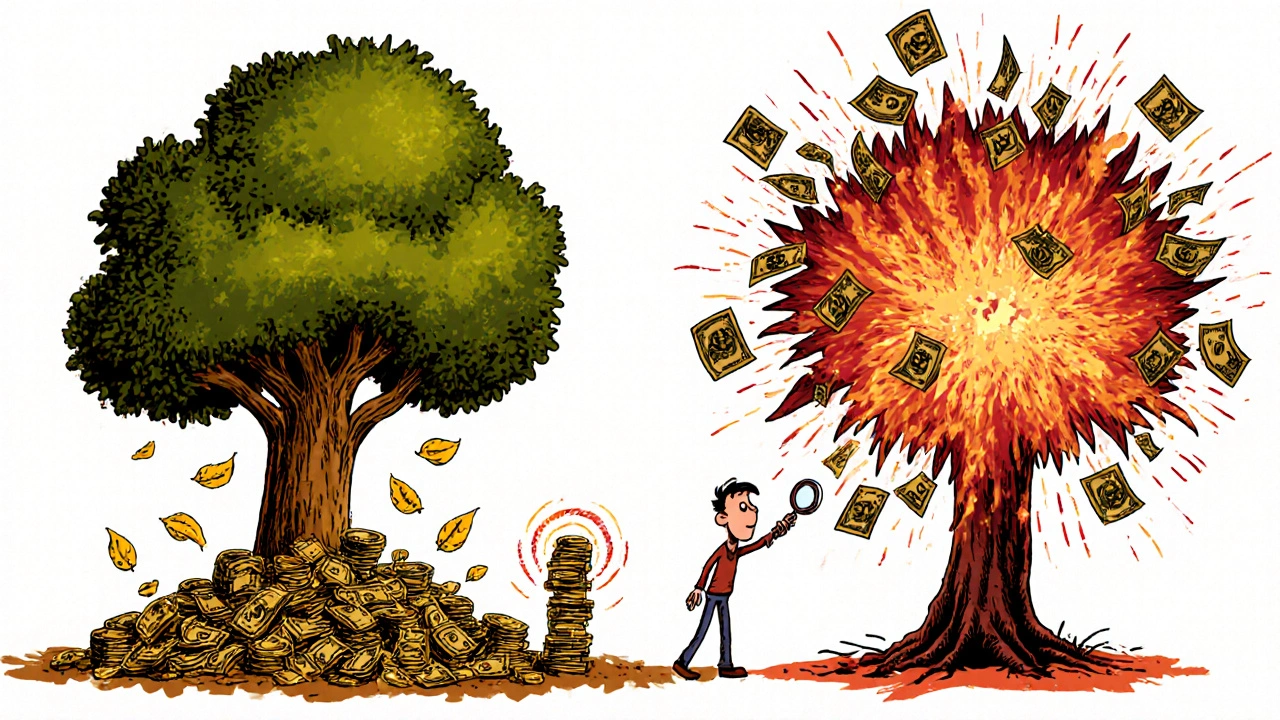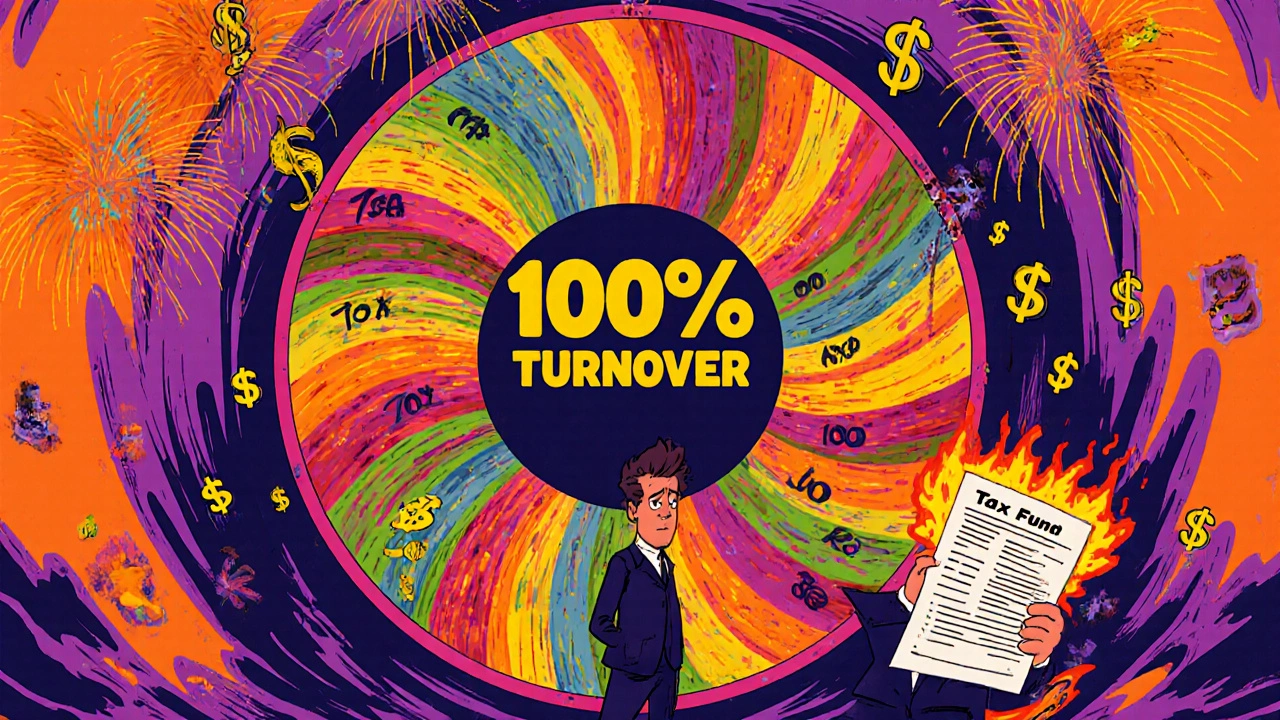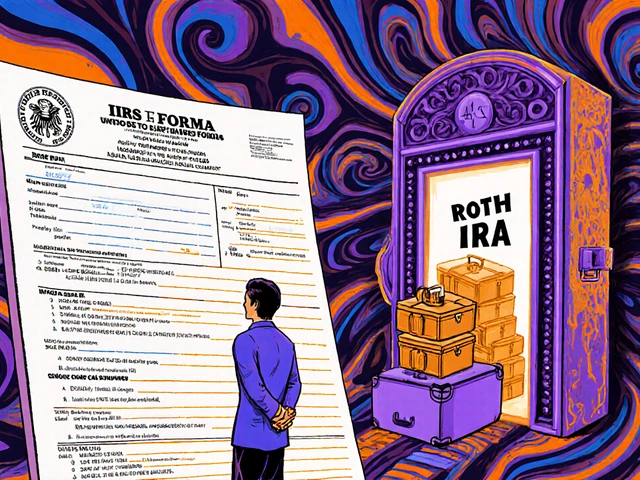Fund Turnover Tax Impact Calculator
Tax Drag Effect
For every 100% increase in turnover, after-tax returns decrease by 0.5-1.0% per year
Your fund's turnover rate of % creates tax drag
After-Tax Return
Your expected after-tax return after turnover effects
Potential Future Value
Your investment value after years
What This Means for Your Investment
The fund's turnover rate of % reduces your returns by . Over years, you could lose in potential growth.
For example, a $10,000 investment could grow to instead of due to tax drag.
When you invest in a mutual fund or ETF, you’re not just buying shares-you’re also buying the fund’s trading habits. And those habits can quietly eat away at your returns, not through bad stock picks, but through something far more invisible: fund turnover.
What Fund Turnover Really Means
Fund turnover measures how often the assets inside a fund are bought and sold over a year. It’s shown as a percentage. A 100% turnover rate means the fund replaced its entire portfolio once in that year. A 30% rate means only a third of the holdings changed hands. Simple, right? But here’s the catch: that number isn’t just a statistic. It’s a direct link to how much you pay in taxes and trading fees.The calculation is straightforward: take the lesser of total purchases or sales during the year, then divide it by the fund’s average assets under management. Securities with less than a year to maturity are excluded. This method is required by the SEC and used by every major fund in the U.S. and UK. You’ll find it in the fund’s annual report, usually near the performance data.
But what does that number actually tell you? A low turnover fund-say, under 30%-is likely tracking an index like the S&P 500 or following a buy-and-hold value strategy. These funds trade rarely. High turnover funds-100% or more-are actively managed, constantly shifting positions based on market timing, sector bets, or short-term trends. Some aggressive funds even hit 300% to 400% turnover, meaning they replaced their portfolio three or four times a year.
Why High Turnover Costs You Money
Every time a fund buys or sells a stock, it pays a commission or spreads cost. These aren’t fees you see on your statement-they’re built into the fund’s expense ratio and quietly drag down returns. But the real killer? Taxes.When a fund sells a stock it’s held for less than a year, it creates a short-term capital gain. Those gains are taxed at your ordinary income rate-which in 2025 can be as high as 37%. If the fund held that stock for over a year, the gain becomes long-term, taxed at 0%, 15%, or 20%, depending on your income. That’s a massive difference.
Here’s the kicker: even if you didn’t sell your shares, the fund can still distribute those gains to you. And you still owe taxes on them. That’s called a capital gains distribution. It happens every year, even if the fund’s overall value dropped. In 2024, the average mutual fund reduced investor returns by 1.4% to 2.4% annually just through tax drag, according to Lipper research cited by Anchor Capital Advisors.
Think about that: if your fund returns 8% before taxes, but 2% of that is lost to taxes, you’re only seeing 6%. And if you’re in a high tax bracket, it could be even worse. Charles Schwab’s research shows that for every 100% increase in turnover, after-tax returns drop by 0.5% to 1% per year. That’s not a small gap-it’s the difference between doubling your money in 12 years versus 16.
ETFs vs. Mutual Funds: The Hidden Tax Advantage
ETFs don’t get the same bad rap as mutual funds for turnover, and it’s not just because they’re cheaper. It’s because of how they’re built.Traditional mutual funds buy and sell stocks directly with cash. When investors redeem shares, the fund must sell stocks to raise cash-and that triggers taxable events for everyone still holding the fund.
ETFs work differently. They use an in-kind creation and redemption process. Authorized participants exchange baskets of stocks for ETF shares, or vice versa. No cash changes hands in these transactions. That means the ETF can swap out low-basis shares without triggering capital gains. It’s a tax-efficient engine built into the structure.
As a result, ETFs have much lower turnover rates on average-around 35%-compared to 61% for U.S. equity mutual funds. And even when they do trade, they’re far less likely to pass taxable gains to investors. That’s why many investors now prefer ETFs for taxable accounts, even when tracking the same index.

High Turnover Isn’t Always Bad-But It’s Risky
Some high-turnover funds deliver strong returns. A skilled manager might outperform by timing the market or catching short-term trends. But the data doesn’t lie: high turnover funds are more likely to fail.According to Personal Fund’s analysis, funds with turnover above 100% go out of business more often than low-turnover funds. Why? Because the costs pile up. Trading fees, management expenses, and tax drag all chip away at returns. Even if the fund beats the market on paper, after costs and taxes, it might underperform a simple index fund.
There’s also a behavioral risk. High turnover often means the manager is chasing performance. That leads to buying high and selling low-exactly what investors are told not to do. The fund might look great in a bull market, but when volatility hits, those frequent trades become expensive mistakes.
What You Should Do: A Practical Guide
You don’t need to avoid all actively managed funds. But you do need to ask the right questions before investing.- Check the turnover rate. Look at the fund’s annual report or fact sheet. Anything over 100% should raise a red flag unless you’re certain the strategy justifies it.
- Compare before-tax and after-tax returns. If the fund’s after-tax return is 30% lower than its before-tax return, you’re paying too much in taxes. That’s a warning sign.
- Hold high-turnover funds in tax-advantaged accounts. IRAs, 401(k)s, and Roth accounts shield you from capital gains distributions. That’s where aggressive, high-turnover funds belong-not in your taxable brokerage account.
- Look for tax-managed funds. Some mutual funds now offer separate share classes designed specifically for taxable accounts. These funds aim for turnover under 20% and actively harvest losses to offset gains. Russell Investments and others have pioneered these strategies.
- Use tax-loss harvesting yourself. If you hold individual stocks or ETFs in a taxable account, sell losing positions to offset gains elsewhere. This can reduce your tax bill by thousands over time.

Good Turnover vs. Bad Turnover
Not all trading is harmful. Russell Investments calls it “tax-smart turnover.” Good turnover happens when a fund:- Sells losing positions to lock in tax losses (tax-loss harvesting)
- Rebalances to maintain target allocations without triggering unnecessary gains
- Uses in-kind swaps or other techniques to avoid taxable events
Bad turnover is when a fund sells winning stocks just because they went up-creating taxable gains with no strategic benefit. That’s pure tax drag.
The key is intent. A fund that trades to manage risk or reduce tax burden is doing smart work. A fund that trades because the manager can’t decide what to hold? That’s just noise.
The Bigger Picture: Why This Matters Over Time
Turnover isn’t just a year-to-year number. It’s a compounding force. A 1% annual tax drag might seem small. But over 20 years, that’s the difference between your $100,000 investment growing to $466,000-or just $321,000. That’s $145,000 lost to taxes you didn’t have to pay.As tax rates stay elevated and investment horizons stretch longer, turnover efficiency will become as important as expense ratios. Investors are waking up to this. More funds are launching tax-managed versions. More advisors are screening portfolios for turnover before recommending them.
If you’re investing for the long term, don’t just look at performance. Look under the hood. How often is this fund trading? Who’s paying the tax bill? And is that cost worth the potential return?
What is a good fund turnover rate?
A good turnover rate depends on your goals. For index funds or buy-and-hold strategies, under 30% is ideal. For actively managed funds, anything under 50% is considered moderate. Turnover above 100% is high and should be carefully evaluated-especially in taxable accounts. The average U.S. equity mutual fund has a turnover rate of 61%, but ETFs average just 35% due to their structural tax advantages.
Does high turnover always mean poor performance?
Not always, but it usually does. High turnover increases trading costs and tax liabilities, which eat into returns. Studies show that high-turnover funds underperform low-turnover funds after costs and taxes, even if they beat the market on paper. They also have higher failure rates-many shut down because they can’t sustain the expense burden. A few skilled managers may outperform, but the odds are stacked against them.
Should I avoid mutual funds with high turnover?
If you’re investing in a taxable account, yes-avoid high-turnover mutual funds. They generate capital gains distributions you can’t control, and you’ll owe taxes on them even if you didn’t sell. Instead, use low-turnover funds, ETFs, or tax-managed share classes. High-turnover funds can still be useful in tax-advantaged accounts like IRAs or 401(k)s, where taxes don’t apply until withdrawal.
How do ETFs avoid taxes even with turnover?
ETFs use an in-kind creation and redemption process. Instead of selling stocks for cash when investors redeem shares, they swap baskets of securities directly with authorized participants. This avoids realizing capital gains. As a result, ETFs rarely distribute taxable gains to shareholders-even if they trade frequently. This structural advantage makes ETFs far more tax-efficient than mutual funds, even when tracking the same index.
What is tax-loss harvesting and how does it help?
Tax-loss harvesting is when a fund or investor sells an investment at a loss to offset capital gains elsewhere. This reduces your taxable income. Some tax-managed funds actively harvest losses throughout the year, using those losses to cancel out gains from other trades. This turns what would be a tax liability into a tax savings. It’s a smart way to make turnover work for you instead of against you.
Can I reduce tax drag without switching funds?
Yes. Hold high-turnover funds in tax-advantaged accounts like IRAs or 401(k)s. In taxable accounts, use tax-loss harvesting on your own holdings to offset gains from your funds. Also, consider switching to ETFs or tax-managed mutual fund share classes, which are designed to minimize distributions. Monitoring turnover before investing is the best prevention.






Comments
Let’s be real-most mutual funds are just overpriced gambling dens with a Bloomberg terminal and a PowerPoint deck titled 'We’re Not Like the Others.' Turnover isn’t just a metric; it’s a tax siphon disguised as active management. I’ve seen funds with 400% turnover that underperformed SPY by 3% annually after taxes. The manager’s ego? That’s the only thing that’s actively managed.
This is one of the clearest explanations of fund turnover I’ve ever read. The part about in-kind ETF redemptions finally made sense to me-no cash changing hands means no forced capital gains. I used to think ETFs were just cheaper, but now I see they’re structurally smarter. Thank you for highlighting tax-loss harvesting too. That’s a quiet superpower most investors overlook.
Are you kidding me? 61% average turnover for U.S. mutual funds? That’s not ‘active management’-that’s financial pyrotechnics with a side of tax arson. I’ve watched funds I invested in in 2020 distribute $8k in capital gains while the portfolio was down 5%. I didn’t sell a single share. I was literally taxed on phantom losses. This isn’t investing-it’s a rigged game where the house prints the money and you pay the gas bill.
YASSS. I’ve been screaming this from the rooftops since 2021. ETFs are the OG tax-efficient flex. No one talks about how the in-kind mechanism is basically magic. Mutual funds are like your uncle who buys and sells crypto every week-loud, chaotic, and always owing the IRS. Meanwhile, ETFs glide through like a ninja in a tax-free zone. If you’re holding high-turnover junk in your taxable account, you’re not investing-you’re donating to the IRS. Move it to your 401(k). Or better yet-swap it for a low-turnover ETF and thank me later. 💸✨
Thank you for this. Very helpful. 🙏